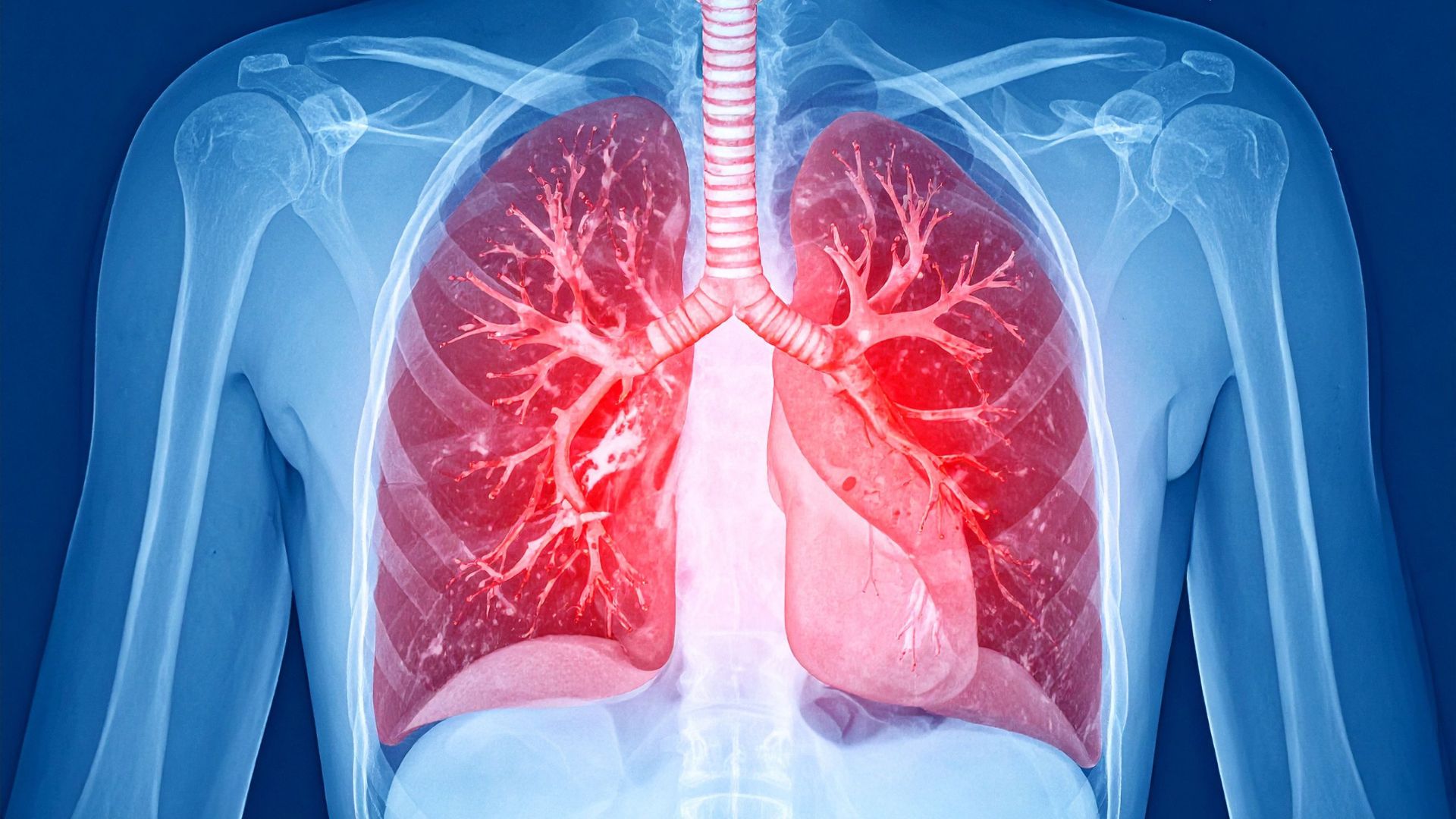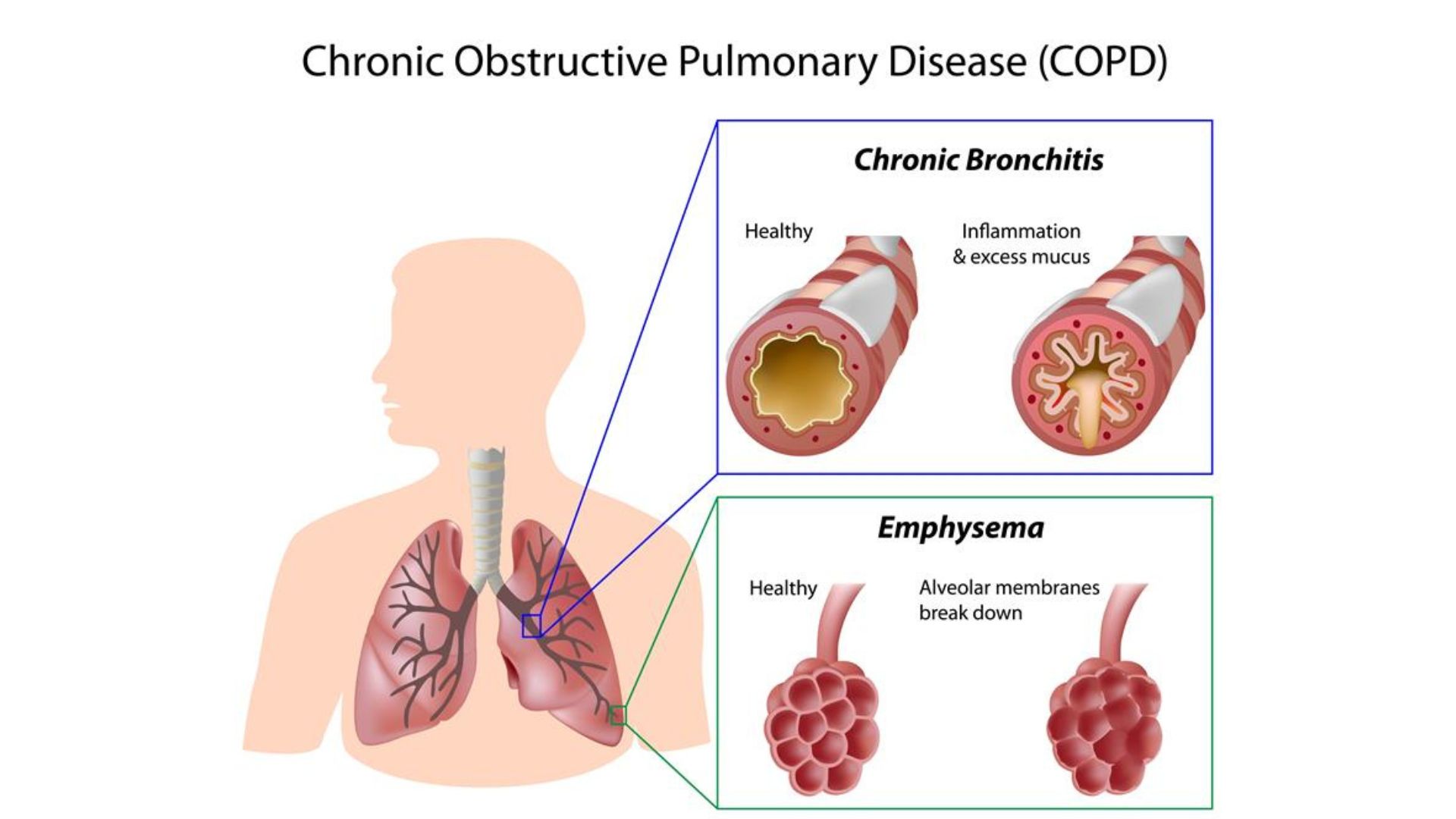Your airways start at the entrance to your nostrils and go down to tiny sacs in your lungs called alveoli, via a series of tubes, like an upside- down tree. They are your respiratory system whose function is to obtain oxygen from the inspired air and to pass out a waste product, carbon dioxide.

Your airways fulfil the following roles:
For your lungs to function well in all these tasks, it is important to keep your airways healthy. This includes avoiding exposure to smoke, chemicals, and other substances that can irritate or damage them.
Chronic obstructive pulmonary disease, or COPD, is a term used to describe a group of lung diseases caused by damage to the lungs. The damage leads to swelling and irritation, also called inflammation. This inflammation and narrowing of the airways makes it harder for air to flow in and out, also referred to as airflow obstruction. This can leave you feeling breathless. COPD is a common condition that affects millions of people and is sadly the fourth leading cause of death worldwide.
Let’s break down the word COPD:
COPD is a lung disease that makes it hard to breathe. It includes emphysema and chronic bronchitis, which can often occur together.
In emphysema, the thin walls of the air sacs of the lungs, called alveoli, become damaged over time. In healthy lungs, the elastic air sacs stretch and fill with air when you breathe in, and help get the air out when you exhale. When the air sacs are damaged, they lose their elasticity and the evacuation of air becomes difficult, leaving less room for fresh, oxygen-rich air to enter your lungs. This process causes shortness of breath and a wheezing sound upon exhaling. Because the overall surface area for gas exchange is reduced, the lungs also become less efficient at taking up oxygen.
Chronic bronchitis on the other hand refers to a lung condition where the lining of the tubes that bring air into the lungs, called bronchi, are affected by inflammation. Due to the inflammation, the bronchi are swollen and narrowed. Moreover, extra mucus is being produced caused by the irritation, leading to blockage of the airways. A persistent cough results from trying to evacuate this mucus from the airways.

While COPD can often be prevented, once it develops, it cannot be cured. The breathing problems tend to get gradually worse over time. The good news is that COPD is treatable. There are treatments to help improve your symptoms and quality of life. Proper management also lowers the risk of other conditions that are linked to COPD, such as heart disease. However, it is important to know that even if you are receiving treatment, you may sometimes notice a sudden worsening of your symptoms. This is called a flare-up or exacerbation.
COPD happens when the lungs become inflamed, damaged, and narrowed. The most common cause in developed countries is tobacco smoking. The risk of developing COPD goes up the longer and the more a person smokes. In developing countries, COPD is often the result of indoor (for example cooking fumes or heating fuels in poorly ventilated rooms) or outdoor air pollution. While smoking is the leading cause of COPD, it is important to know that about 1 in 4 people with COPD never smoked.
Other risk factors of COPD may include:
For a long time, COPD was thought to be a disease that mostly affected older men, because men smoked more. But recent data show a shift: COPD is now common in women, and in many developed countries is actually more frequent in women than in men.
Women seem to be at a greater risk of developing COPD. They may develop COPD at a younger age and can have just as much lung damage as men, with fewer years of smoking. This suggests that women’s lungs may be more sensitive to the harmful effects of smoking.
Sadly, women also seem to be at a higher risk of hospitalisation and even death related to the disease. The reasons behind this are largely unknown, but some theories exist. It might be linked to female hormones (estrogen), smaller airways, and increased exposure to tobacco smoking and cooking fumes/fuels. Women with COPD also often experience worse lung function, more frequent flare-ups, and poorer quality of life compared to their male counterparts.
The good news is that current COPD treatments work just as well for women as they do for men.
Truth: Although smoking is the main cause of COPD, about one in four people with the disease have never smoked. In these cases, COPD is often linked to conditions affecting the lungs of children (including maternal smoking during pregnancy, premature birth, childhood infections), asthma, or asthma, or a rare genetic condition called alpha-1-antitrypsin deficiency.
Truth: It is common to avoid activity when breathing becomes difficult, but this might actually make things worse by reducing your level of fitness and confidence, leading to even more breathlessness. The good news is that exercise can help improve breathing and ease symptoms. Find activities that feel comfortable, taking regular breaks, and gradually increasing your activity level can make a big difference. It is important to consult a healthcare professional to help guide you on safe exercises and help set goals that work for you.
Truth: While COPD is more common in older people, younger adults can also be affected, especially those with a genetic condition called alpha-1-antitrypsin deficiency. Most diagnoses happen after age 40, but knowing the early warning signs is important, particularly if you are current or former smoker. Early diagnosis and treatment can help slow down lung damage.
Truth: It is never too late to quit! You can still get major health benefits, such as slowing lung damage, improving your quality of life, and lowering your risk of lung cancer, stroke and heart attacks. Tobacco smoke also irritates the lungs and thus make COPD symptoms worse, so quitting will help you breathe easier. That said, we know quitting smoking is hard — even if you’re motivated and fully aware of the health risks. The good news is there’s excellent help available to support your quit journey, so reach out to your healthcare professional for the guidance you need.
Truth: Although smoking is the main cause of COPD, about one in four people with the disease have never smoked. In these cases, COPD is often linked to conditions affecting the lungs of children (including maternal smoking during pregnancy, premature birth, childhood infections), asthma, or asthma, or a rare genetic condition called alpha-1-antitrypsin deficiency.
Truth: For a long time, COPD was thought to mostly affect men, but recent data show a shift. COPD is now common in women, and in some developed countries it is even more frequent in women than in men. Women also seem at a greater risk of developing COPD, possibly because their lungs are more sensitive to the harmful effects of smoking, although other factors such as hormones and indoor air pollution may also play a role. If you’re a woman with ongoing breathing problems, it is important to get them checked out.
Truth: When people have ongoing breathing problems, their biggest fear is often lung cancer. But once cancer is ruled out, COPD can be overlooked. Stopping the search for answers too soon means missing the chance for an early COPD diagnosis. Early diagnosis is essential to try and slow down lung function decline and allow timely treatment. If you have long-term breathing issues, it is important to get them properly checked out.
This website does not provide medical advice.
The information, including but not limited to text, graphics, images, and other material contained on this website, is for informational purposes only. No material on this site is intended to be a substitute for professional medical advice, diagnosis, or treatment and/or medical treatment by a qualified physician or healthcare provider. EUFOREA is not a medical organisation and cannot provide specific medical advice to patients via the Internet and/or Email. All patients are encouraged to direct their specific questions to their personal physicians. EUFOREA presents this information to patients so that patients can understand and participate in their own medical care. EUFOREA strongly emphasises that the information contained on this website is not a substitute for thorough evaluation and treatment by a qualified healthcare provider.
© 2025 - EUFOREA - All rights reserved. All content on this portal, such as text, graphics, logos and images, is the property of EUFOREA. They may not be reproduced, copied, published, stored, modified or used in any form, online or offline, without prior written permission of EUFOREA.